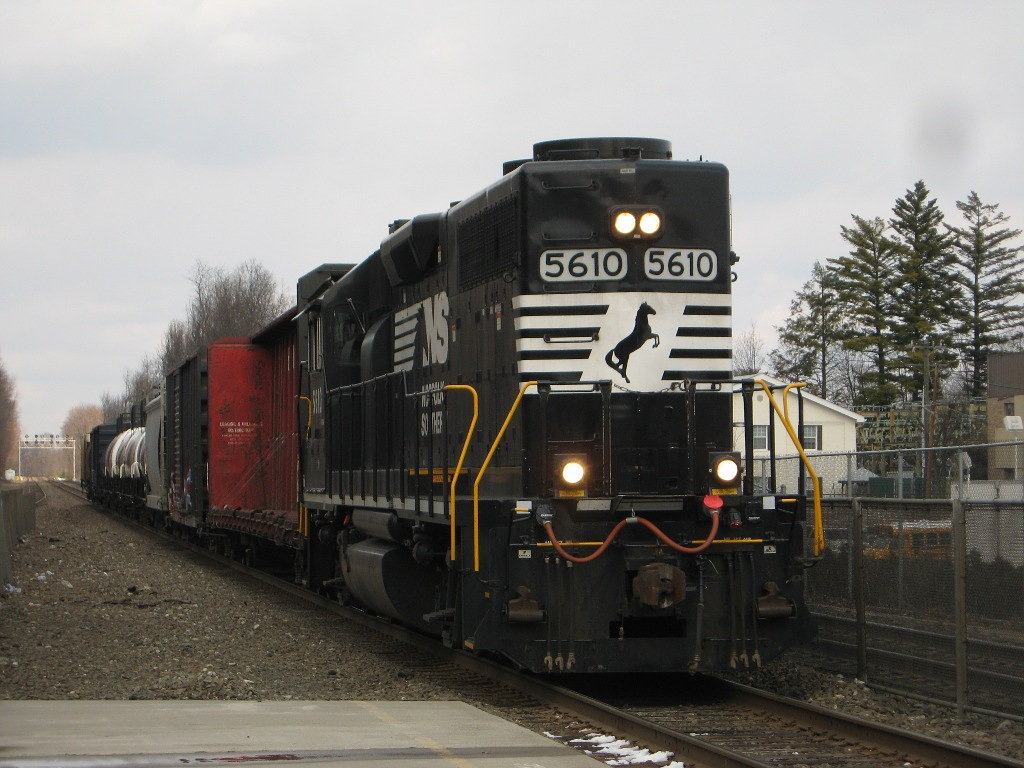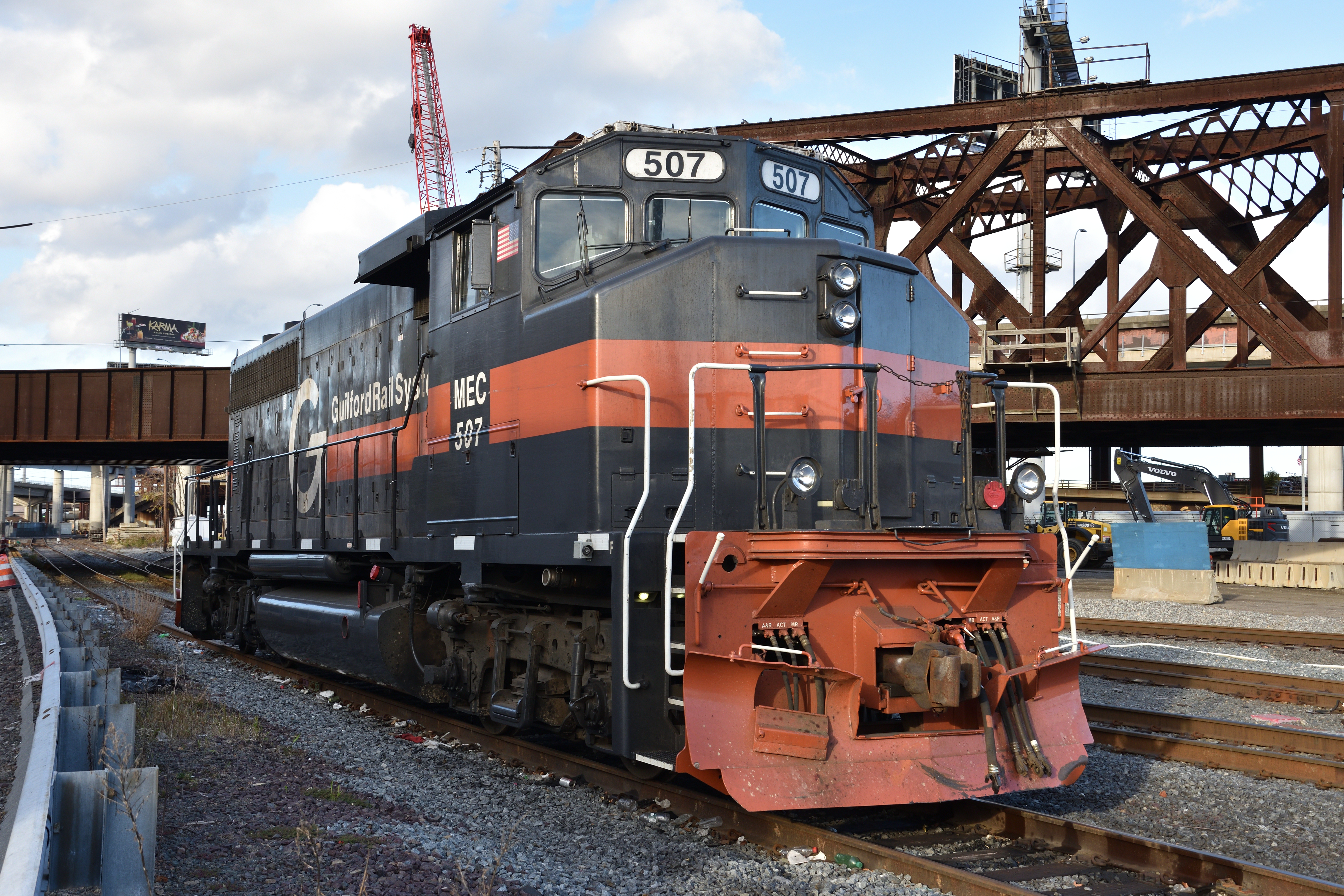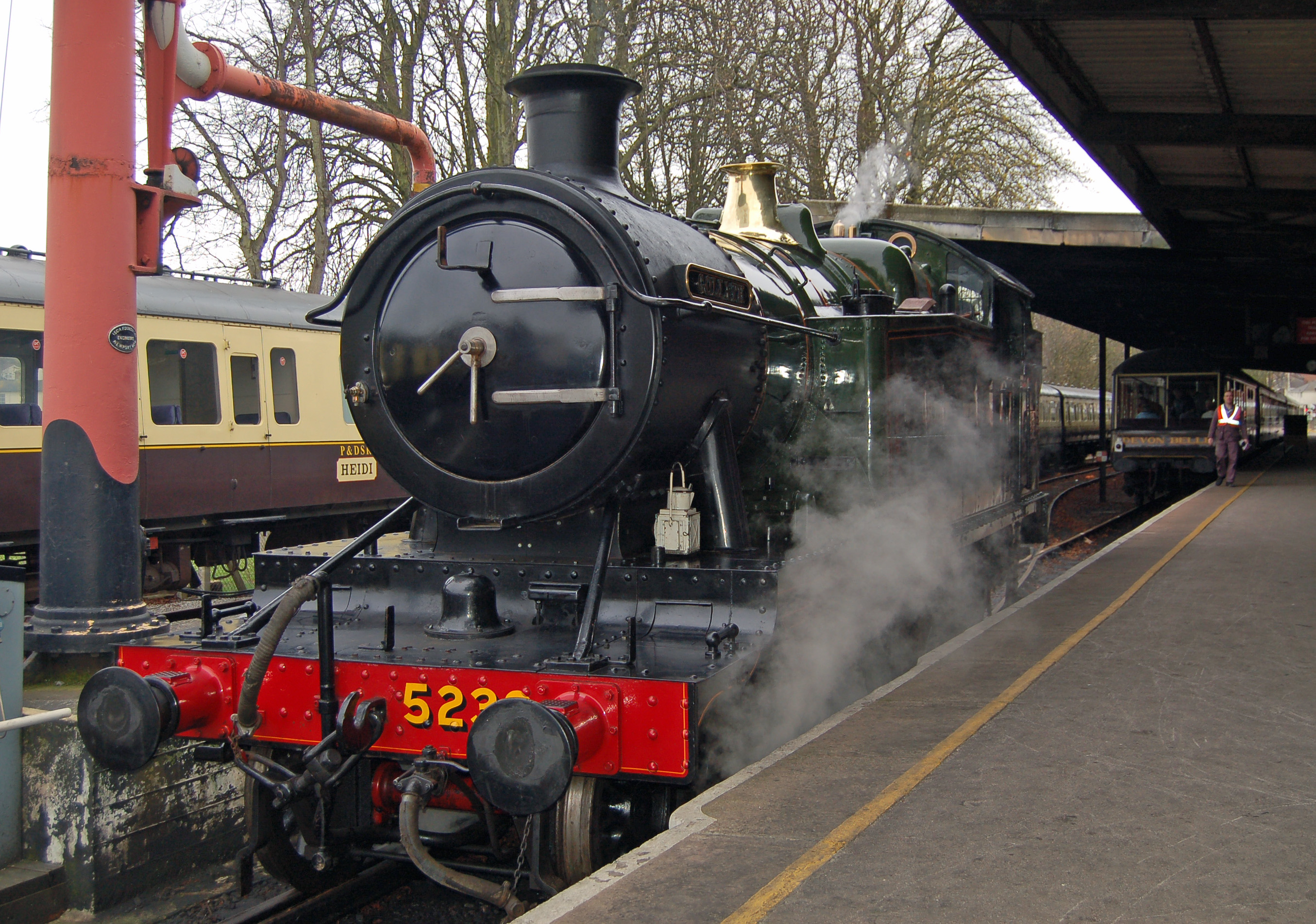|
EMD GP40
The GP40 is a 4-axle diesel-electric locomotive built by General Motors' Electro-Motive Division between November 1965 and December 1971. It has an EMD 645E3 16-cylinder engine generating . The GP40 is longer than its EMD 567D3A-engined predecessor, the GP35, and distinguished visually by its three 48-inch radiator fans at the rear of the long hood, while the GP35 has two large fans and a smaller one in between. It was built on a frame; the GP35 was built on a frame - as was the GP7, 9, 18, and 30. The difference in length can be seen in the GP40's ten handrail stanchions compared to the GP35's nine. 1,187 GP40s were built for 28 U.S. railroads; 16 were built for one Canadian carrier, Canadian National; and 18 were built for two Mexican carriers, Ferrocarril Chihuahua al Pacífico and Ferrocarriles Nacionales de México. 60 units were built with high-short-hoods and dual control stands for Norfolk & Western Railway. Two passenger versions, the GP40P and GP40TC, were ... [...More Info...] [...Related Items...] OR: [Wikipedia] [Google] [Baidu] |
Canadian National
The Canadian National Railway Company (french: Compagnie des chemins de fer nationaux du Canada) is a Canadian Class I railroad, Class I freight railway headquartered in Montreal, Quebec, which serves Canada and the Midwestern United States, Midwestern and Southern United States. CN is Canada's largest railway, in terms of both revenue and the physical size of its rail network, spanning Canada from the Atlantic coast in Nova Scotia to the Pacific coast in British Columbia across approximately of track. In the late 20th century, CN gained extensive capacity in the United States by taking over such railroads as the Illinois Central. CN is a public company with 22,600 employees, and it has a market cap of approximately CA$90 billion. CN was government-owned, having been a Crown corporations of Canada, Canadian Crown corporation from its founding in 1919 until being privatized in 1995. , Bill Gates is the largest single shareholder of CN stock, owning a 14.2% interest throu ... [...More Info...] [...Related Items...] OR: [Wikipedia] [Google] [Baidu] |
Long Hood Forward
The long hood of a hood unit-style diesel locomotive is, as the name implies, the longer of the two hoods (narrower sections of the locomotive body in front and behind of the cab) on a locomotive, particularly American-type freight locomotives. Equipment The long hood normally contains the diesel engine (prime mover), the main generator or alternator, the locomotive's cooling radiators, the dynamic brake resistor grids if fitted, and most of the locomotive's auxiliary equipment. Head-end power equipment, if fitted, is normally in the long hood; steam generators for heating older passenger cars may be either in the long or short hoods. Operating direction Normally, the long hood is the rear of the locomotive. For early hood unit models, this was not the case; railroads preferred to run with the long hood at the front and the cab at the rear (referred to as operating long hood forward or LHF). It is a common misconception that locomotives were run LHF to provide greater prote ... [...More Info...] [...Related Items...] OR: [Wikipedia] [Google] [Baidu] |
Dakota, Minnesota And Eastern Railroad
The Dakota, Minnesota and Eastern Railroad is a wholly owned U.S. subsidiary of the Canadian Pacific Railway. Before its purchase, it was the largest Class II railroad in the United States, operating across South Dakota and southern Minnesota in the Northern Plains of the United States. Portions of the railroad also extended into Wyoming, Nebraska, Iowa, and Illinois. It interchanged with all seven U.S. Class I railroads. The DM&E began operations on September 5, 1986, over trackage spun off from the Chicago and North Western Transportation Company in South Dakota and Minnesota. The DM&E purchased the assets of I&M Rail Link railroad in 2002, renaming it Iowa, Chicago and Eastern Railroad. DM&E combined its management and dispatching duties with those of ICE under the holding company Cedar American Rail Holdings. The combined system connected Chicago through Iowa to Kansas City, Minneapolis-St. Paul and continued west to Rapid City, South Dakota. Smaller branches extended into ... [...More Info...] [...Related Items...] OR: [Wikipedia] [Google] [Baidu] |
EMD GP22ECO
The EMD GP22ECO is a B-B diesel-electric locomotive rebuilt by Electro-Motive Diesel and Norfolk Southern's Juniata Shops. Initially EMD built two GP22ECO demonstrators, one based on a GP9 and one based on a GP40, but thus far all orders have been for conversions based on EMD GP40 and EMD GP40-2 series locomotives. The rebuild involves replacing the existing prime mover with an EPA Tier-II-compliant turbocharged V8 710G3A, with Electronic fuel injection. The prime mover is mated to an AR10 alternator for traction power, a CA6 alternator for control power, and a computerized control system. Applying this to a 6-axle locomotive results in a SD22ECO. Some 6-axle locomotives could alternately be converted into a SD32ECO, using a V12 V12 or V-12 may refer to: Aircraft * Mil V-12, a Soviet heavy lift helicopter * Pilatus OV-12, a planned American military utility aircraft * Rockwell XFV-12, an American experimental aircraft project * Škoda-Kauba V12, a Czechoslovak expe ... [...More Info...] [...Related Items...] OR: [Wikipedia] [Google] [Baidu] |
EMD GP40-2
The EMD GP40-2 is a 4-axle diesel locomotive built by General Motors Electro-Motive Division as part of its Dash 2 line between April 1972 and December 1986. The locomotive's power is provided by an EMD 645E3 16-cylinder engine which generates . Production Standard GP40-2 production totaled 861 units, with 817 built for U.S. railroads, and 44 for Mexican railroads. In addition, three GP40P-2s, passenger versions of the GP40-2, were built in 1974 and 279 were built by General Motors Diesel (GMD) between 1974 and 1976. Total production of the GP40-2 and its variations totaled 1,143 units. Performance With the 62:15 gearing (65-70 mph maximum) EMD rated the GP40-2 at 55,400 lb continuous tractive effort. Some had PF21 module that reduced the output below 23 mph, lowering continuous speed down to 11 mph. Original buyers ;GP40-2LW ;GP40P-2 Preservation Sonora Baja California 2107 is now preserved in a Museum in Mexicali, MX See also *List of ... [...More Info...] [...Related Items...] OR: [Wikipedia] [Google] [Baidu] |
Head End Power
In rail transport, head-end power (HEP), also known as electric train supply (ETS), is the electrical power distribution system on a passenger train. The power source, usually a locomotive (or a generator car) at the front or 'head' of a train, provides the electricity used for heating, lighting, electrical and other 'hotel' needs. The maritime equivalent is hotel electric power. A successful attempt by the London, Brighton and South Coast Railway in October 1881 to light the passenger cars on the London to Brighton route heralded the beginning of using electricity to light trains in the world. History Oil lamps were introduced in 1842 to light trains. Economics drove the Lancashire and Yorkshire Railway to replace oil with coal gas lighting in 1870, but a gas cylinder explosion on the train led them to abandon the experiment. Oil-gas lighting was introduced in late 1870. Electrical lighting was introduced in October 1881 by using twelve Swan carbon filament incandescent lamps c ... [...More Info...] [...Related Items...] OR: [Wikipedia] [Google] [Baidu] |
Steam Generator (railroad)
A steam generator is a type of boiler used to produce steam for climate control and potable water heating in railroad passenger cars. The output of a railroad steam generator is low pressure, saturated steam that is passed through a system of pipes and conduits throughout the length of the train. Steam generators were developed when diesel locomotives started to replace steam locomotives on passenger trains. In most cases, each passenger locomotive was fitted with a steam generator and a feedwater supply tank. The steam generator used some of the locomotive's diesel fuel supply for combustion. When a steam generator-equipped locomotive was not available for a run, a so-called "heating car" fitted with one or two steam generators was inserted between the last locomotive in the consist and the rest of the train. Steam generators would also be fitted to individual cars to enable them to be heated independently of any locomotive supply. In Ireland, Córas Iompair Éireann used "heat ... [...More Info...] [...Related Items...] OR: [Wikipedia] [Google] [Baidu] |
GP40TC
The passenger locomotives derivatives of the General Motors EMD GP40 diesel-electric locomotive have been, and continue to be, used by multiple passenger railroads in North America. For passenger service, the locomotives required extra components for providing steam or head-end power (HEP) for heating, lighting and electricity in passenger cars. Most of these passenger locomotives were rebuilt from older freight locomotives, while some were built as brand new models. GP40TC The GMD GP40TC was built by General Motors Diesel (GMD), for GO Transit in Toronto. Eight units were manufactured between 1966 and 1968. They were built on an enlarged frame to accommodate a head-end power generator. GO Transit sold the fleet to Amtrak in 1988, where they were based in Chicago and used on short-haul trains. In 2005, the Norfolk Southern Railway rebuilt all eight GP40TC locomotives at its Juniata Shops in Altoona, Pennsylvania. These are now classed as GP38H-3, and work as maintenance-of- ... [...More Info...] [...Related Items...] OR: [Wikipedia] [Google] [Baidu] |
GP40P
The passenger locomotives derivatives of the General Motors EMD GP40 diesel-electric locomotive have been, and continue to be, used by multiple passenger railroads in North America. For passenger service, the locomotives required extra components for providing steam or head-end power (HEP) for heating, lighting and electricity in passenger cars. Most of these passenger locomotives were rebuilt from older freight locomotives, while some were built as brand new models. GP40TC The GMD GP40TC was built by General Motors Diesel (GMD), for GO Transit in Toronto. Eight units were manufactured between 1966 and 1968. They were built on an enlarged frame to accommodate a head-end power generator. GO Transit sold the fleet to Amtrak in 1988, where they were based in Chicago and used on short-haul trains. In 2005, the Norfolk Southern Railway rebuilt all eight GP40TC locomotives at its Juniata Shops in Altoona, Pennsylvania. These are now classed as GP38H-3, and work as maintenance- ... [...More Info...] [...Related Items...] OR: [Wikipedia] [Google] [Baidu] |
EMD GP40-based Passenger Locomotives
The passenger locomotives derivatives of the General Motors EMD GP40 diesel-electric locomotive have been, and continue to be, used by multiple passenger railroads in North America. For passenger service, the locomotives required extra components for providing steam or head-end power (HEP) for heating, lighting and electricity in passenger cars. Most of these passenger locomotives were rebuilt from older freight locomotives, while some were built as brand new models. GP40TC The GMD GP40TC was built by General Motors Diesel (GMD), for GO Transit in Toronto. Eight units were manufactured between 1966 and 1968. They were built on an enlarged frame to accommodate a head-end power generator. GO Transit sold the fleet to Amtrak in 1988, where they were based in Chicago and used on short-haul trains. In 2005, the Norfolk Southern Railway rebuilt all eight GP40TC locomotives at its Juniata Shops in Altoona, Pennsylvania. These are now classed as GP38H-3, and work as maintenance-of- ... [...More Info...] [...Related Items...] OR: [Wikipedia] [Google] [Baidu] |
Norfolk & Western Railway
The Norfolk and Western Railway , commonly called the N&W, was a US class I railroad, formed by more than 200 railroad mergers between 1838 and 1982. It was headquartered in Roanoke, Virginia, for most of its existence. Its motto was "Precision Transportation"; it had a variety of nicknames, including "King Coal" and "British Railway of America". In 1986, N&W merged with Southern Railway to form today’s Norfolk Southern Railway. The N&W was famous for manufacturing its own steam locomotives, which were built at the Roanoke Shops, as well as its own hopper cars. After 1960, N&W was the last major Class I railroad using steam locomotives; the last remaining Y class 2-8-8-2s would eventually be retired between 1964 and 1965. In December 1959, the N&W merged with the Virginian Railway (reporting mark VGN), a longtime rival in the Pocahontas coal region. By 1970, other mergers with the Nickel Plate Road and Wabash formed a system that operated of road on of track from North Ca ... [...More Info...] [...Related Items...] OR: [Wikipedia] [Google] [Baidu] |





.jpg)
